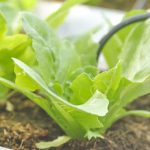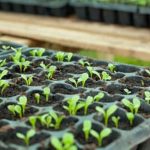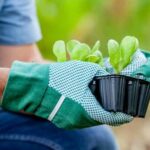Are you interested in starting your own vegetable garden at home? Whether you’re a beginner or an experienced gardener, a home vegetable gardening book can provide you with valuable tips, techniques, and advice to help you grow a successful garden. In this article, we will cover the essential aspects of home vegetable gardening, from choosing the right location for your garden to harvesting and preserving your home-grown produce.
To start off, we will provide an overview of home vegetable gardening and why it’s beneficial to grow your own produce. We will also discuss the various advantages of having a vegetable garden at home, including access to fresh and nutritious vegetables, cost savings, and the satisfaction of growing your own food.
Next, we will delve into the important factors to consider when choosing the location for your vegetable garden. From sunlight exposure to soil quality, we will explore how these elements can impact the success of your garden. We will also discuss how to prepare the soil and create an optimal growing environment for your vegetables.
Additionally, we will highlight the essential tools and supplies needed for home vegetable gardening. From basic hand tools to irrigation systems, we will cover everything you need to effectively maintain and care for your garden. Lastly, we will provide recommendations for home vegetable gardening books that are ideal for beginners looking to learn more about this rewarding hobby.
Choosing the Right Location for Your Vegetable Garden
Considering Sun and Shade
In addition to considering sunlight, it’s important to also consider the presence of shade in your chosen location. Some vegetables, such as lettuce and spinach, can benefit from some shade during the hottest part of the day, while others, like tomatoes and peppers, thrive in full sun.
Soil Quality and Drainage
Another important factor to consider when choosing a location for your vegetable garden is the quality of the soil and its drainage. Most vegetables prefer well-drained soil that is rich in organic matter. You can have your soil tested by a local agricultural extension service or use a home testing kit to determine its pH levels and nutrient content.
Accessibility
Lastly, you’ll want to consider the accessibility of your chosen location. Make sure it’s convenient for you to access on a regular basis for watering, weeding, and harvesting. If your garden is too far away from your home, you may be less likely to give it the attention it needs. Keep these factors in mind when choosing a location for your vegetable garden to set yourself up for a successful growing season.
Essential Tools and Supplies for Home Vegetable Gardening
When starting your home vegetable garden, it is important to have the essential tools and supplies to ensure that you can effectively plant and maintain your garden. Here are some of the must-have items for any home vegetable gardener:
- Garden Spade or Fork: These tools are essential for turning over soil, digging holes for planting, and loosening compacted soil.
- Hand Trowel: A small hand trowel is perfect for planting seedlings and small plants, as well as digging up weeds.
- Watering Can or Hose: Proper irrigation is crucial for the health of your plants, so make sure you have a reliable watering can or hose to keep your garden hydrated.
- Pruners or Shears: Keeping your plants well-maintained and trimmed is important for their growth, so invest in a good pair of pruners or shears.
In addition to tools, there are also several supplies that you will need to have on hand for successful home vegetable gardening:
- Organic Fertilizer: Providing nourishment to your plants with organic fertilizer will help them grow healthy and strong.
- Mulch: Mulch helps to retain moisture in the soil, suppress weeds, and regulate soil temperature. This is especially important during hot summer months.
- Seed Starter Trays and Pots: If you plan on starting your vegetables from seeds, having seed starter trays and pots will be necessary for germination and early growth stages.
By having these essential tools and supplies on hand, you will be equipped to start your own successful home vegetable garden.
For further guidance on choosing the right tools and supplies specifically tailored to beginner gardeners, consider checking out a reputable home vegetable gardening book which can provide detailed lists of essential equipment needed to get started with this fulfilling hobby.
Selecting the Best Vegetables for Your Garden
When it comes to selecting the best vegetables for your garden, there are a few important factors to consider. First and foremost, you should take into account your local climate and growing conditions. Different vegetables thrive in different climates, so it’s crucial to choose varieties that are well-suited to your specific area. For example, leafy greens like lettuce and spinach tend to do well in cooler climates, while heat-loving plants like tomatoes and peppers prefer warmer temperatures.
Additionally, you’ll want to think about your own personal preferences and dietary needs. Do you enjoy eating certain vegetables more than others? Are there specific veggies that you use regularly in your cooking? It’s a good idea to prioritize growing vegetables that you and your family will actually enjoy eating. You should also consider any dietary restrictions or health goals when making your selections.
Lastly, consider the amount of space you have available for gardening. If you’re working with limited space, you may want to focus on smaller plants or varieties that can be grown vertically. On the other hand, if space isn’t an issue, you might have more flexibility in terms of which vegetables you can grow.
Once these factors have been taken into consideration, it’s time to start researching specific varieties of vegetables that are suitable for your garden. Fortunately, there are many resources available to help guide your decision-making process, including reputable home vegetable gardening books for beginners that offer detailed information on different types of vegetables and how to grow them successfully.
| Consideration | Action |
|---|---|
| Local climate and growing conditions | Choose varieties well-suited to the area |
| Personal preferences and dietary needs | Prioritize growing vegetables enjoyed by family |
| Space availability | Select plants based on available space |
Planting and Caring for Your Vegetable Garden
Once you have chosen the right location for your vegetable garden and gathered your essential tools and supplies, it’s time to start planting and caring for your crops. Before planting, it’s important to prepare the soil properly. This may involve testing the soil pH, adding organic matter such as compost, and ensuring proper drainage.
When it comes to actually planting your vegetables, it’s important to follow spacing recommendations on seed packets or plant labels. This will ensure that each plant has enough room to grow and thrive. Proper watering is also crucial during this stage. While it’s important not to overwater, underwatering can also be detrimental to your plants.
Caring for your vegetable garden also involves regular maintenance such as weeding, mulching, and fertilizing. Keeping an eye out for signs of pests or diseases is crucial, as addressing these issues early can prevent them from spreading and damaging your crops.
| Aspect | Recommendation |
|---|---|
| Soil Preparation | Test soil pH and add organic matter like compost |
| Plant Spacing | Follow spacing recommendations on seed packets or plant labels |
| Weeding and Maintenance | Regular weeding, mulching, fertilizing and pest control are necessary tasks |
Dealing With Common Pests and Diseases in Home Vegetable Gardening
When it comes to home vegetable gardening, dealing with common pests and diseases is an inevitable part of the process. However, there are several measures that can be taken to prevent and manage these issues effectively.
Here are some tips for dealing with common pests and diseases in your vegetable garden:
- Regular inspection: Keep a close eye on your plants for any signs of pest infestation or disease. Early detection can make a huge difference in preventing the spread of these issues.
- Implement companion planting: Some plants can repel pests or attract beneficial insects that can help control pest populations. Consider incorporating companion plants, such as marigolds or basil, into your garden layout.
- Organic pest control methods: Embrace organic pest control methods, such as handpicking pests, using insecticidal soaps, or employing natural predators like ladybugs and praying mantises.
- Proper watering and fertilization: Overwatering or under-fertilizing your plants can make them more vulnerable to diseases. Maintain proper watering and feeding schedules to keep your plants healthy and resistant to common ailments.
By being proactive and implementing these strategies, you can minimize the impact of pests and diseases on your home vegetable garden. Additionally, referring to a reputable home vegetable gardening book will provide valuable insights into identifying, preventing, and managing common issues in a practical manner.
Harvesting and Preserving Your Home-Grown Produce
When your home vegetable garden starts to yield an abundant harvest, it can be both exciting and overwhelming. Knowing when and how to harvest your produce is essential for maximizing flavor and freshness. Additionally, learning how to properly preserve your fruits and vegetables will allow you to enjoy them well beyond the growing season.
Harvesting Your Home-Grown Produce
The key to harvesting your home-grown produce is timing. Different vegetables have different indicators for when they are ready to be harvested, such as size, color, and firmness.
For example, tomatoes should be picked when they are fully colored and slightly soft to the touch, while lettuce can be harvested when the leaves reach a size that is suitable for the type of lettuce you are growing. It’s important to regularly check on your garden and watch for these indicators to ensure that you don’t miss the prime harvesting window.
Preserving Your Harvest
Once you’ve harvested your fruits and vegetables, you’ll want to make sure they stay fresh for as long as possible. There are several methods of preserving produce including canning, freezing, drying, pickling, and fermenting. Each method has its own set of requirements and best practices.
For example, canning typically involves placing food in jars and boiling them to destroy any microorganisms present while freezing requires properly packaging produce in airtight containers or bags. Understanding which method works best for each type of produce will help prolong the shelf life of your home-grown goods.
Using Your Home-Grown Produce
Having a bountiful supply of home-grown fruits and vegetables provides endless opportunities for delicious meals and snacks. Whether you choose to use them in salads, stir-fries, soups, smoothies or eat them raw as a healthy snack – there is no end to the ways you can enjoy the fruits of your labor from your home vegetable garden book.
Enjoy experimenting with different recipes and cooking methods as a way of savoring all the hard work that went into growing your produce.
Recommended Home Vegetable Gardening Books for Beginners
Are you a beginner home vegetable gardener looking for some guidance and inspiration to start your own garden? Look no further. There are plenty of great resources out there, including books specifically tailored for beginners in home vegetable gardening. These books offer valuable insights, tips, and step-by-step instructions to help you get started on the right foot.
One highly recommended home vegetable gardening book for beginners is “The Vegetable Gardener’s Bible” by Edward C. Smith. This comprehensive guide covers everything from planning and preparing your garden to selecting the best vegetables for your space and caring for them throughout the season. The book also includes helpful information on composting, pest control, and harvesting techniques.
Another excellent resource is “Square Foot Gardening” by Mel Bartholomew. This innovative approach to gardening focuses on maximizing yields in minimal space while minimizing work. The book provides detailed plans for creating raised beds and offers guidance on how to plant a variety of vegetables using the square foot method.
If you’re interested in organic gardening, “The Beginner’s Guide to Organic Gardening” by Sannel Larson is a fantastic choice. This book not only covers the basics of setting up and maintaining a successful vegetable garden but also emphasizes the importance of sustainable and eco-friendly practices.
These recommended home vegetable gardening books are just a few examples of the many valuable resources available to beginner gardeners. By investing in one or more of these guides, you can arm yourself with the knowledge and confidence needed to embark on your own successful vegetable growing journey.
Advanced Techniques for Maximizing Your Vegetable Garden Yield
Once you have mastered the basics of home vegetable gardening, you may be ready to take your skills to the next level by maximizing your garden yield. There are several advanced techniques that experienced gardeners use to get the most out of their vegetable gardens.
One advanced technique for maximizing vegetable garden yield is succession planting. This involves planting new crops as soon as one harvest is finished, extending the growing season and increasing overall yield. By carefully planning your planting schedule, you can ensure a continuous supply of fresh produce throughout the growing season.
Another advanced technique for maximizing vegetable garden yield is companion planting. This strategy involves planting certain crops together to benefit each other in some way, such as deterring pests or improving nutrient uptake. By carefully selecting which vegetables to plant next to each other, you can create a more productive and resilient garden.
In addition to succession planting and companion planting, advanced vegetable gardeners may also explore techniques such as vertical gardening, intercropping, and intensive spacing. These methods require careful planning and management, but they can significantly increase the productivity of your vegetable garden. For more in-depth information on these advanced techniques and how to apply them in your own garden, consider consulting a reputable home vegetable gardening book for detailed guidance.
Success Stories and Tips From Experienced Home Vegetable Gardeners
In conclusion, home vegetable gardening is a rewarding and fulfilling activity that allows individuals to grow their own fresh produce right in their backyard. With the right location, tools, and selection of vegetables, anyone can start their own thriving garden. Dealing with pests and diseases can be challenging, but with the proper knowledge and techniques, it is possible to maintain a healthy garden.
For beginners looking to delve into the world of home vegetable gardening, there are plenty of resources available to help them get started. One such resource is the “home vegetable gardening book” which provides comprehensive information and guidance on every aspect of growing your own vegetables at home. Even experienced gardeners can benefit from these books by learning advanced techniques for maximizing yield and preserving produce.
As seen in the success stories and tips from experienced home vegetable gardeners, the effort put into maintaining a garden pays off with an abundance of fresh, organic produce. The satisfaction of harvesting your own fruits and vegetables cannot be compared to store-bought options. With dedication and commitment, anyone can transform their outdoor space into a flourishing vegetable garden and enjoy the numerous benefits it brings.

If you’re looking to get into vegetable gardening, or are just looking for some tips on how to make your current garden better, then you’ve come to the right place! My name is Ethel and I have been gardening for years. In this blog, I’m going to share with you some of my best tips on how to create a successful vegetable garden.





